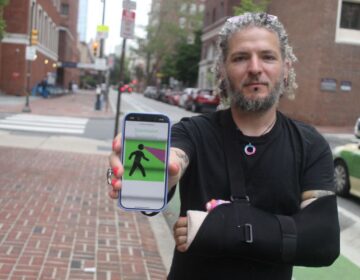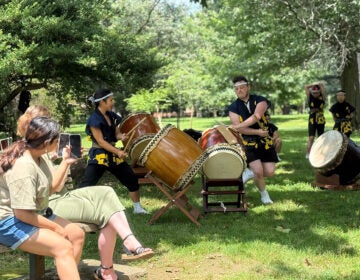Combatting dogfighting in Chicago, a model for Philadelphia
ListenThe Philadelphia Eagles kick-off their playoff run this weekend. Michael Vick’s meteoric rise in the NFL after serving prison time for dogfighting, surprised many fans and animals lovers. With Vick on the team, the Eagles are giving the Humane Society money to try to tackle dogfighting in Philadelphia, by modeling a program that already exists in Chicago and Atlanta.
WHYY’s Elizabeth Fiedler went to Chicago to learn what could be in store for Philadelphia’s dogs and dogfighters.
A cool rain is falling while about a dozen people — many of them kids with dogs in tow — pile into an unassuming squat brick building on the West Side of Chicago. It’s Saturday around noon, the weekly pitbull training class here in the Austin neighborhood is about to start.Fourteen year old Terrence Murphy keeps his gray and white pit bull close-by. He stops every once in a while to stare at the dog lovingly. Speaking after the class, Murphy says his relationship with dogs wasn’t always like this.”I used to fight dogs,” said Murphy. “When I was 8 me and my cousins we used to go into an abandoned house and we used to fight dogs just for the fun of it.” Murphy’s been bringing Cookie Monster here for about eight months, and before that he brought another dog named Elmo. “We used to fight dogs and the ones that was the most in injuries we used to just hang ’em and kill ’em, beat it to death, set it on fire, drown it–all of that unhumane stuff,” said Murphy. “The guys that be on the block, they used to go in abandoned houses and fight dogs and me and my cousins used to go in there and watch ’em, so we thought it was cool so then we started getting dogs and started fighting dogs.”
Murphy says since he started coming to training, his grades have gotten better and he’s trying harder. He says he likes how Cookie Monster respects him.
Another former dogfighter named Anthony Pickett has an idea why Murphy and other young people are benefiting from the training.
Pickett’s job with the End Dogfighting Campaign is to travel the neighborhood recruiting former dogfighters and at-risk dogowners for the pit bull training program. It’s a tough job since many of the fighters are making money and are suspicious he’s with the police.
He says it wasn’t the money that sucked him into the life. “I always had good dogs, big dogs, pretty dogs and everybody wanted me to see if they could fight ’em,” he said. “I ended up doing it just for the challenge.”
Pickett says he gave up dogfighting after he agreed to fight a dog named White Boy, a dog his kids loved.
“He won but he came out real bloody and I couldn’t take him back home to the girls and they asked about this dog for a month almost 2 months,” Pickett said. “But I had to hide him and sew him back up and that stopped me right in my tracks. I didn’t want to hurt my kids. That was their favorite dog.”
Pickett says White Boy wasn’t what he used to be after that fight,
“His ear was damaged, around his face was damaged, his tail was almost broke off from fighting. ‘Cause everything happens in fights: eyes get gouged out, ears get tore off, legs. A dog can come out lookin’ like he’s been in a war within ten minutes of a fight.”
Pickett says Michael Vick’s high profile dogfighting brought the gruesome sport to light, but it’s still happening in the backyards and basements of the neighborhood.
The End Dogfighting Campaign’s approach includes more than just dog training. Sandy DeLisle is the Coordinator of ‘End Dogfighting Chicago’ and manager of urban outreach and humane education.
“We also have an eight week anti-dog-fighting curriculum that we do in conjunction with the Chicago public schools,” said DeLisle. “We also work with law enforcement. We have a rewards program whereby people can call in and report dogfighting anonymously and they can be entitled to up to a $5,000 reward if it leads to the arrest and conviction of a dogfighter.”
Tio Hardiman knows what it’s like. He grew up in the projects on the West side of Chicago and helped set up the End Dogfighting program about five years ago. He says a lot of young guys who came to the early trainings didn’t have proper leashes and food, and didn’t know how to really deal with their dogs.
What started as a training and community outreach program in Chicago’s Austin neighborhood, now includes two other training sites in Chicago and ones in Atlanta and Philadelphia.
Hardiman says about 40 percent of the 200 or so participants at two Chicago centers were actively involved in dogfighting.
Hardiman says he got into this field after noticing many of the guys he worked with doing violence prevention work on the streets of Chicago, toted along malnourished and injured pit bulls.
“A lot of things go on in the neighborhood, you know, people sell narcotics, people shoot one another, and they fight dogs, and you got prostitution goin’ on, and you name it: alcoholism, drug addiction, so it’s just a part of everyday life in the ghetto,” said Hardiman.
Hardiman says Michael Vick represents a lot of young people across the country who are growing up in a culture of violence.
“He’s given his testimony to young men and women across America and educating these guys, sayin’ look, ‘I fell from a high place in society and you normally don’t get a second chance,” Hardiman said.Hardiman says there’s a connection between fighting pit bulls and struggling to live in a violent society. He says keeping guys out of the world of dogfighting is good for them, their dogs, their families, and the rest of the community.
“Now this guy is making sure his dog gets his shots, he’s making sure it’s eating a balanced diet,” he said. “It’s very important. These guys are making sure the dogs get the proper exercise. It opens up a world of opportunity for these young men.”
Hardiman says there are three levels of dogfighting: the hobbyists who might fight their dogs for $100 to see if their animal has the fight in them; dog owners who could make from $500 to $1,500 fighting their dogs in garages, backyards, and basements; and high level dogfighting operations – similar to what Michael Vick was involved in – that involve big money.
Hardiman says the End Dogfighting Campaign is focused on people in the lower levels, as well as dog owners at risk of getting into fighting.
Back at the training class, Jeff Jenkins, the lead trainer for the End Dogfighting Campaign Pitbull Training Team, is laying out the ground rules,
“Rule #1. No hittin’, kickin’, or screamin’, yellin’ at your dog. Rule #2. Both hands on the leash at all times.”
Jenkins goes on to warn participants not to let the dogs interact with each other. He has a firm but friendly approach. Still, as the class begins, with so many people and their barking, squirming dogs filling up the small room, it feels like things aren’t far from total canine chaos.
The dog owners, mostly young kids, are lined up along the walls dogs at their sides, listening to Jenkins. Orange cones and some hurdles for the dogs to jump over are set-up around the room.
Jenkins starts leading the group through basic skills.
“Come around the cone and then you’re going to go all the way back to the box,” Jenkins said. “Nice clean sit. And treat, and praise. Cookie Monster, let’s see it!”
Terrence Murphy leads Cookie Monster through the routine with ease. Murphy’s proud of the dog, and Jenkins is proud of both of them.
“This is an 8-month-old puppy guys and look at the focus he’s gettin’,” said Jenkins. “Ears are up, tails up, waggin’, he’s excited.”
Jenkins has been doing the work for about four years and says it’s never dull. “The biggest challenge inititally is getting the young men to buy in,” he said. “You know, these young men come from communities that are horribly underserved, under-funded, so to get them to take time out of their struggle to survive to engage their dog in a productive, positive way is a challenge.”
Jenkins says the campaign to end dogfighting isn’t just an animal welfare campaign, it’s a human welfare campaign too. “All the skills that they learn in here are applicable to any real life situation,” he said. “We know first hand that the young men in our program if they start to excel here, they start to excel in life across the board: in school, dealing with their friends outside.”
Standing outside the training center, with his dog at his side, Harry Cannon says there’s a simple reason he brings his two year old pit to training.
“If she’s tired, she’s more calm and listening but if she hadn’t been worked out all day she’ll be more active I like to see my dog doin’ good in obedience. I don’t like her wild,” Cannon said. ” I never had to fight dogs. I used to breed ’em but now since I started comin’ to class, it’s more about performance.”
WHYY is your source for fact-based, in-depth journalism and information. As a nonprofit organization, we rely on financial support from readers like you. Please give today.




